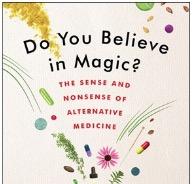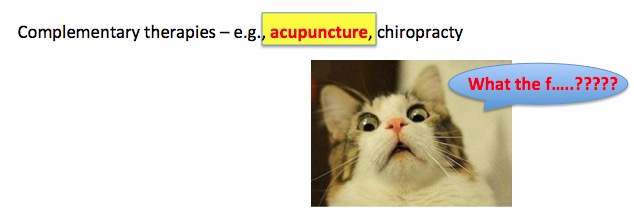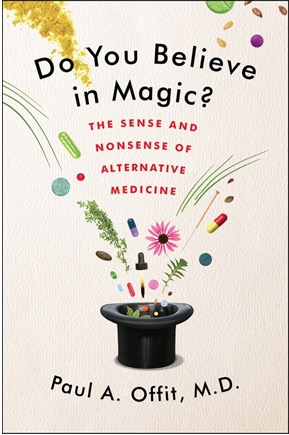
Back in May, the FDA issued a blueprint of proposed changes for physicians who manage pain.
"FDA Education Blueprint for Health Care Providers Involved in the Management or Support of Patients with Pain"
OK, nothing wrong with a little extra education, right? Or maybe there is, depending on what is being taught. Prepare yourself...
II. "NONPHARMACOLOGIC THERAPIES"
A number of nonpharmacologic therapies are available that can play an important role in managing pain, particularly musculoskeletal pain and chronic pain."
- Psychological approaches – e.g., cognitive behavioral therapy •
- Physical rehabilitative approaches – e.g., physical therapy, occupational therapy •
- Surgical approaches •
- Complementary therapies – e.g., acupuncture, chiropracty
Let's take another look at that last one...

So, the FDA is endorsing acupuncture??? The blueprint was issued in May, so it can't be an April fool's joke. They must be serious, right? Well, Paul Offit, who is seriously brilliant, an expert on quackery, and (in my opinion) a public health hero is serious, as well. And he has some things to say about this topic. Dr. Offit, who is the Director of the Vaccine Education Center at the Children’s Hospital of Philadelphia and a Professor of Vaccinology and Pediatrics at the Children's Hospital of Philadelphia (1) wrote a must-read book which debunks many of today's most egregious medical myths. One of them is acupuncture. Let's take a look at what Dr. Offit has to say.

Put this on your reading list. Now. Photo: Paul Offit Books
Do you know the basis for acupuncture? I sure didn't until I read that Chapter 1. After that, whatever smidgeon of an open mind I had about acupuncture vanished immediately.
"...[I]n the second century B.C. Chinese healers [reasoned] that diseases were caused by an imbalance of energies. [They] treated this imbalance by placing a series of thin needles under the skin."
OK, that's not so bad. If the Chinese had a vague idea about the nervous system maybe that's what "energy" means. Or not.
"[Since] Chinese physicians were prohibited from dissecting human bodies, they didn't know that nerves originated in the spinal cord. In fact, they didn't know what nerves were. Or what the spinal cord was. Or what the brain was."
This raises the obvious question of what prompted them to use needles in the first place. And also, where to put them. This is where the whole thing falls apart (emphasis mine).
"[T]hey interpreted events inside the body based on what they could see outside, like rivers and sunsets. Chinese physicians believed that energy flowed through a series of twelve meridians that ran in longitudinal arcs from head to toe, choosing the number twelve because there are twelve great rivers in China."
OK, folks. That's more than enough for me. But perhaps I'm too skeptical or jaded. What about those 360 acupuncture points where the needles are carefully placed to release all the excess energy (chi) and restore the balance of the two competing energies - yin and yang?
"The number of acupuncture points—about 360— was determined by the number of days in the year."
So, if I've got this right, sticking needles in places that were determined by geography and chronology 2,000 years ago is medically sound enough so that the FDA is suggesting that doctors learn about it as an alternative to prescribing pain medication? Does anyone see a problem with all of this? Or a reason for it?
Yet, it works. People who receive acupuncture treatments often feel better. It's all in their heads, but it's not their imagination. Their heads are working properly. The placebo effect can be very strong. When released, endorphins, our natural painkillers make us hurt less, just like morphine (1). Placebos cause endorphins to be released. In fact, Offit explains how pain relief from acupuncture is a biological process, which can be blocked by the opioid antagonist naloxone, the same drug that is used for overdose victims.
This is why acupuncture works. But it is nothing but a placebo, which puts acupuncture squarely under the umbrella of alternative medicine. At the Council, we have had plenty to say about complementary medicine, none of it complimentary. And it would be hard to skewer it better than my colleague Dr. Julianna LeMiex (See: JAMA: Journal Of Alternative Medicine Atrocities).
A bigger question is why and how alternative medicine crept its way into our government and has thrived. Hint: it's all about money.
Next: Part II. Where is the money coming from?
NOTES:
(1) There is a 49% placebo effect for people who have headaches and think they've taken Tylenol. (See: Tylenol Isn't So Safe, But At Least It Works, Right?).
(2) I know there are "Offit haters" out there, probably mostly antivaccine screwballs. And yes, he made money with his rotavirus vaccine. Good for him. It has saved hundreds of thousands, perhaps, millions of lives around the world. And it sure works in the US: "Compared with the average rate of rotavirus-coded hospitalizations in 2001–2006, rates were reduced by 75% in 2007–2008, 60% in 2008–2009, 94% in 2009–2010, and 80% in 2010–2011. Compared with unvaccinated children, in 2010–2011, the rate of rotavirus-coded hospitalizations was reduced by 92% ." Source: Pediatrics July 2014, VOLUME 134 / ISSUE 1
(3) Don't bother calling Paul unethical. I will just delete you. I know him. You don't. He is sincere, ethical and brilliant. I don't want to hear it.



